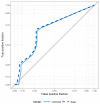Prognostic Role of Circulating miRNAs in Early-Stage Non-Small Cell Lung Cancer
- PMID: 30678026
- PMCID: PMC6407000
- DOI: 10.3390/jcm8020131
Prognostic Role of Circulating miRNAs in Early-Stage Non-Small Cell Lung Cancer
Abstract
Non-small cell lung cancer (NSCLC) is the primary cause of cancer-related death worldwide, with a low 5-year survival rate even in fully resected early-stage disease. Novel biomarkers to identify patients at higher risk of relapse are needed. We studied the prognostic value of 84 circulating microRNAs (miRNAs) in 182 patients with resected early-stage NSCLC (99 adenocarcinoma (ADC), 83 squamous cell carcinoma (SCC)) from whom peripheral blood samples were collected pre-surgery. miRNA expression was analyzed in relation to disease-free survival (DFS) and overall survival (OS). In univariable analyses, five miRNAs (miR-26a-5p, miR-126-3p, miR-130b-3p, miR-205-5p, and miR-21-5p) were significantly associated with DFS in SCC, and four (miR-130b-3p, miR-26a-5p, miR-126-3p, and miR-205-5p) remained significantly associated with OS. In ADC, miR-222-3p, miR-22-3p, and mir-93-5p were significantly associated with DFS, miR-22-3p remaining significant for OS. Given the high-dimensionality of the dataset, multivariable models were obtained using a regularized Cox regression including all miRNAs and clinical covariates. After adjustment for disease stage, only miR-126-3p showed an independent prognostic role, with higher values associated with longer DFS in SCC patients. With regard to ADC and OS, no miRNA remained significant in multivariable analysis. Further investigation into the role of miR-126 as a prognostic marker in early-stage NSCLC is warranted.
Keywords: early-stage NSCLC; miRNAs; plasma; prognosis.
Conflict of interest statement
The authors declare no conflicts of interest.
Figures


References
LinkOut - more resources
Full Text Sources
Research Materials

